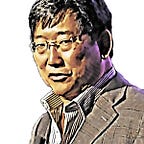AI in Medicine‘s Biggest Challenge
At the AIMed 2022 Global Summit I was joined on the stage by eight members of our moon shot mission crew to discuss the many challenges in transforming children’s healthcare with artificial intelligence.
The conclusion of a recent report by the EU on AI in healthcare makes four recommendations. The only technical recommendation is to enable the access, use and sharing of healthcare data. AI in medicine’s biggest challenge is to enable the access, use and sharing of healthcare data. There are many roadblocks and objections to being able to access, use and share healthcare data, which was told from many the clinical, IT and legal perspectives.
Our story begins with Dr. Anthony Chang taking my cloud computing class at Stanford. There, he shared with me the sad story of a little girl in Myanmar dying because the clinicians could not share an echocardiogram with Anthony. Inspired by Anthony’s passion and experience, we launched a moon shot mission to create a new generation of transformative AI applications based on access, use and sharing of healthcare data from all 500 children’s hospitals in the world.
But just to be clear the interesting healthcare data is NOT in the EMR/EHR, it’s in the 1,000,000 machines (ultrasounds, blood analyzers, gene sequencers, ventilators) in all 500 children’s hospitals in the world. And do NOT put the data in central repositories. It’s not the right approach technically and it’s not the right approach from a privacy point of view.
Such an ambitious project requires a village, multiple companies, people, clinicians and hospitals.
Dr. Charitha Reddy is Clinical Assistant Professor at Stanford Children’s Hospital and began our session. We met about 2 years ago. She had a vision of being able to use large amounts of diverse echo data to transform pediatric cardiology. Below you’ll see a chart sharing the challenges on her journey. Her Echo Net Peds application will shortly go live on eight edge zones around the world.
We were lucky early in the mission when Leanne West, Chief Engineer of Pediatric Technologies at Georgia Tech, introduced us to Mark Lalande, VP Research at Shriners Children’s. Cole Hilton is the Corporate Research Data Manager, and part of the research team talked about how on the 100th anniversary of Shriner Children’s the edge cloud, data sharing and AI are part of the next 100 years.
Of course with Anthony being the inspiration, CHOC had to be one of the Vanguard Hospitals. Eventually in every conversation with clinicians we end up talking to IT. We were pleased to have Adam Gold, Chief Technology Officer at CHOC, join the panel. Adam started out by saying when he brought the idea of deploying the edge cloud at CHOC his IT team said, “no way”. He walked us through all of the internal processes which has resulted in the first edge zone in the world running at CHOC.
You might have all heard statements like: “We have very strict rules about PHI and HIPAA”, “The main blockers are patient consent”. We’re lucky enough to have one of my former students joining our panel, Mirena Taskova, who has 15 years of experience in privacy law and has contributed to the privacy architecture of the edge cloud. Mirena walked thru five misconceptions in privacy law. Consider reading our post Privacy is NOT a reason to slow down AI in medicine.
While privacy has legal and operational challenges, there are innovative technologies to advance state of the art Artificial Intelligence. We launched BevelCloud with the mission of enabling a new generation of healthcare applications based on access to the data in all 1,000,000 healthcare machines in all 500 children’s hospitals in the world. Travis Shanhan, who is chief architect at BevelCloud, covered the innovative security and privacy features we’ve developed in the edge cloud. He also highlighted the Chang Method, which is designed to take AI innovations from research paper to the bedside.
The moon shot mission from day 1 was a global mission. Alberto Tozzi, who is both the incoming president of International Society for Pediatric Innovation and a clinician at Bambino Gesu, one of the largest children’s hospitals in Europe. Alberto talked about how he’s seen central repositories fail over and over again. Then he discussed the challenges on implementing the first edge zone outside of the United States and the potential to make software be the engine for innovation in pediatrics.
Staying in Europe, I introduced our seventh panelist, Darren Gates. Darren Pediatric Intensivist and AI clinical lead at Alder Hey Children’s Hospital in the UK. He is passionate about harnessing AI to make healthcare even better. We’re currently scheduling the first edge zone deployment in the NHS. Darren focused on the promise of using federated learning to train AI applications, while preserving privacy.
Finally, joining us all the way from Lebanon was Fatme Charafeddine, a Pediatric Cardiac Electrophysiologist at the American University of Beirut-Medical Center. Fatme brought it back to the real objective we all have, which is children’s healthcare. She relayed the story of a 9 year old girl, who she was unable to save. Sadly, software with the ability to access, use and share EKG data (not paper output) would have been able to change the outcome.
I started the session by saying that it takes a village to get to the moon. All eight of our crew members wore the Star Trek Medical Insignia at the conference. They were quite the hit with many people asking, where they could get one. If you’d like to join the mission and boldly go where no one has gone before, let any of us know. There may be an insignia in your future.
